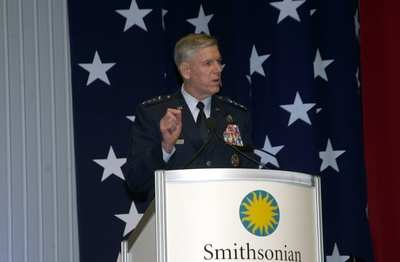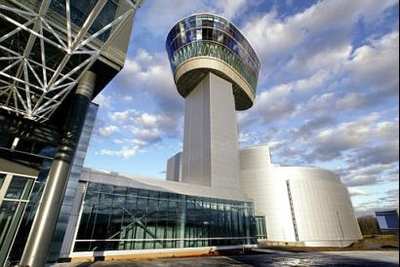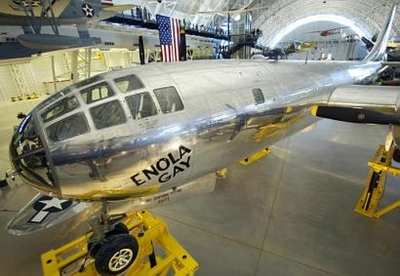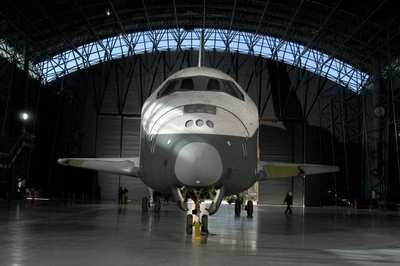Priority Given FIRST To Nation's Vets
One of the most popular museums of the Smithsonian Institution
celebrated its expansion with a preview day honoring military
aviation veterans.

Military aviators from conflicts as far back as World War II
were invited to the "Salute to Military Aviation Veterans" Dec. 9,
at the National Air and Space Museum's new Steven F. Udvar-Hazy
Center. The center is located in Chantilly Va., less than 30 miles
from the museum's flagship building in Washington.
The chairman of the joint chiefs of staff, Gen. Richard B. Myers
(above), addressed event attendees.
"For a century, America's aviation veterans have bravely
explored and expanded the limits of air power," Myers said. "They
made America an air power -- the most innovative and respected in
the world today."
Examples of that air power, both old and new, were on display.
Among the 82 aircraft shown were the B-29 Superfortress
“Enola Gay,” the space shuttle Enterprise, an SR-71
Blackbird, a test model of the Joint Strike Fighter and the
Concorde.
The aviation hangar at the heart of the center is nearly 10
stories tall and the length of three football fields. Aircraft are
displayed at floor level and suspended from the ceiling at various
heights. Visitors can view the collection from the floor or any of
several catwalks that crisscross the hangar.
Eventually, the center will house 200 aircraft, 135 space
artifacts and thousands of smaller aviation-related items. Nearly
80 percent of the air and space museum's aircraft will be put on
display at the center.
Some World War II aviation veterans in attendance were amazed at
the array of aircraft on display and said they enjoyed the
opportunity to revisit the aircraft they had flown nearly 60 years
before.

Retired Lt. Col. Milton W. Sanders joined the Army Air Corps in
1941 and flew 116 missions over Europe. He has 8,000 career flying
hours, with more than 1,000 in the P-47. He said he was amazed at
the size of the center.
"This is fantastic," Sanders said. "It's going to take you a
week to really go through the place."
Sanders, now 86 and in a wheelchair, was accompanied by his son
and granddaughter. He took them to see the P-47D Thunderbolt.
"The P-47 was the most fantastic aircraft the Air Force ever
had," he said.
Sanders said he remembers a mission he flew in the P-47 near the
Loire River in southern France.
"About 20,000 soldiers from the German army were on foot coming
from Italy back to Germany," he said. "It was our job to suppress
them."
Under the barrage of artillery the P-47 threw down, it did not
take long for the Germans to surrender, he said.
"That was the first time an army of that size surrendered to air
power alone," Sanders said.

George Baker served in the Army Air Corps in the Pacific from
1940 to 1946. He was in training at Hickam Field, Hawaii, when the
Japanese bombed Pearl Harbor. He said the displays bring back
memories for him, but hopes they will give something to younger
generations as well.
"This is great and is incredibly educational," Baker said. "I
hope they bring all the school kids here to see what aviation is
all about. School kids today don't really know much about the
history of flying."
Retired Col. Bob Shawn, a B-29 pilot with nearly 18,000 hours in
the cockpit during his 30-year career, agreed with Baker.
"The kids need to learn about World War II as well," Shawn said.
He wore an early Army Air Corps uniform to the event. "Some of the
schoolbooks today have only a few pages on that war. I don't
understand how they can reduce a war that took six years to fight
into just a few pages."
It is to men like Shawn, Baker and Sanders that America owes a
debt of gratitude for the freedom we enjoy, Myers told the crowd of
nearly 4,000 attendees.
"In 100 years, in only one century, we've come from the Wright
Flyer to this airplane before us," Myers said, pointing to the
experimental version of the Joint Strike Fighter on display.
"(We've gone) from canvas and hope, to stealth and a little magic.
It's all because brave American military aviators, brave Americans
who risked their lives and limb, (who) slipped the surly bonds of
Earth risking all to keep America free."
Myers also acknowledged the contributions of modern-day aviators
who were also in the audience.

"We must remember that American aviators and the rest of our
armed forces and our coalition partners are engaged in the war on
terror," Myers said. "I am very proud of those defending liberty
today with courage and skill, in today's armed forces. It was the
dedication and vision and determination of America's aviation
veterans that really made contributions to America's freedom in the
last century right through to today. That spirit lives on in one
continuum as we fight this war on terrorism."
The center opens to the public Dec. 15. The opening coincides
with celebrations marking the 100-year anniversary of the first
powered flight near Kitty Hawk, N.C. [ANN Thanks Staff Sgt. C. Todd
Lopez, AFPN]
 Airborne 11.05.25: Tesla Flying Car?, Jepp/ForeFlight Sold, A220 Troubles
Airborne 11.05.25: Tesla Flying Car?, Jepp/ForeFlight Sold, A220 Troubles Airborne 11.07.25: Affordable Expo Starts!, Duffy Worries, Isaacman!
Airborne 11.07.25: Affordable Expo Starts!, Duffy Worries, Isaacman! Aero-News: Quote of the Day (11.05.25)
Aero-News: Quote of the Day (11.05.25) ANN's Daily Aero-Linx (11.05.25)
ANN's Daily Aero-Linx (11.05.25) NTSB Prelim: Cirrus Design Corp SR22
NTSB Prelim: Cirrus Design Corp SR22






